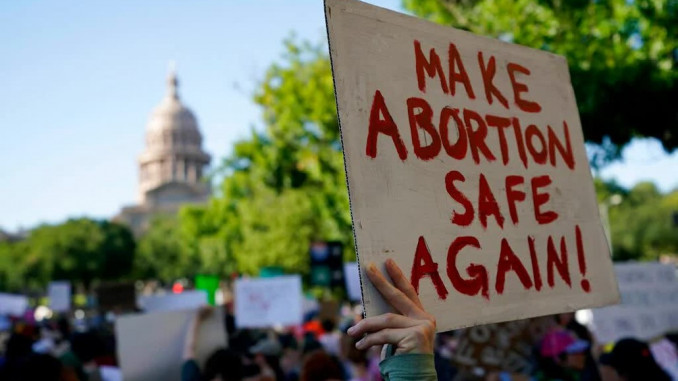
Abortion is now heavily restricted in nearly half of U.S. states, which places a burden on anyone who may become pregnant, but worst of all on the most marginalized – the poor, people of color, trans people, and children impregnated through rape. But these are not the only impacts of these bans. They are also impacting medical providers, who are now put in a situation to have to choose between the life of the pregnant person and their medical license.
While some may have an abortion due to financial hardship, an overburdened family, or simply a desire to live life without a child, many people who choose to be pregnant are faced with the tragic need to terminate their pregnancy because their own life or the life of the fetus is in danger, which endangers the parent in turn. Without access to abortion these patients are forced into a horrible situation – they must avoid lifesaving treatment if they themselves are ill, or in the case of miscarriage, must wait until the fetus evacuates naturally or creates life-threatening symptoms that give them the legal right to seek emergency care. And now doctors may be afraid of intervening in cases when abortion would otherwise be a safe and desirable treatment, because of the fear that the life of the pregnant person wasn’t in “enough” danger according to state law. They face a terrible choice: care for the patient and lose the license or protect the license and risk losing the patient.
About 25 to 27 pregnant people out of 100,000 also have cancer. They most often need chemotherapy to prevent the spread of their disease, but this life-saving treatment puts the fetus in danger. If the life of a fetus is paramount, a pregnancy can mean a person cannot get effective treatment for their cancer. If abortion is not an option, pregnant people with cancer diagnoses must carry their pregnancy to term, and delay treatment. Thus, they may be forfeiting their own life, and often a parent for their already living children, for the sake of the fetus.
The inhumane treatment of pregnant people in Texas and other states is due to a stipulation in the law that says abortion can only be provided when the life of a pregnant person is in immediate danger. Even people who seek abortions following a miscarriage must have a life-threatening condition, such as sepsis or an acute kidney injury, before they can receive an abortion.
In Texas, under current law, in the case of miscarriages in pregnancies that end before ten weeks, pregnant people can usually safely miscarry on their own with few complications. However, patients who experience miscarriages after ten weeks of pregnancy are forced to carry the fetus until it evacuates the vagina on its own, or when the once-pregnant person’s life is in danger.
Dilation and curettage, or D&C, is a necessary treatment for clearing the uterus of those who have miscarried after ten weeks of pregnancy. D&C used to be a routine medical procedure available in Texas. However, with the recent changes to the state’s abortion law, people who have experienced miscarriages after ten weeks of pregnancy are sent home with instructions to return only if the bleeding is excessive (filling a diaper more than once an hour). On average, expelling tissue from a pregnancy that is no longer viable takes nine days. The process is painful, and 57 percent of once-pregnant people end up with serious infections, hemorrhaging, and sometimes life-threatening sepsis. Forcing a person who has experienced a miscarriage to carry their dead fetus until it is expelled naturally can be both physically dangerous and emotionally disturbing, let alone painful.
As a result, the Texas Medical Association received complaints from doctors that hospitals were preventing them from providing medically necessary abortions, and that providers feared legal consequences. Meanwhile, some hospitals have enlisted special panels of doctors and lawyers to decide when a pregnancy can be ended, while others have required multiple doctors to sign off on an abortion procedure with details as to why it was necessary. The result is delayed treatment and heightened risks for patients.
This has created a situation in which medical providers can face an unconscionable choice between their medical license, and a pregnant person’s life. Doctors must answer for themselves, “is a life in immediate danger or not?”
Conservative politicians who support these draconian abortion bans can blame the medical system for any misunderstandings that their laws create, but some will also publicly attack doctors in the national media for choosing to provide abortion care in even exceptionally horrifying incidents of child rape and impregnation. In July, for example, a ten-year-old was raped in Ohio and received an abortion. The Indiana doctor who performed the abortion was defamed in the right wing media and accused of not submitting the necessary paperwork after performing the procedure, which would have terminated her license had it been true. This kind of attack on medical providers threatens other doctors who may want to perform such a procedure.
take this risk.
In 2022 the U.S. has a more conservative reproductive health policy than it had 50 years ago. Ireland now has more progressive laws toward medical abortion than the U.S. We are being taken backwards in time.
Yet despite these roll-backs in reproductive health rights, there are signs of hope. In early August, Kansas was the first state to vote on abortion rights since the U.S. Supreme Court handed down its ruling, and 59 percent of voters voted to reject an amendment to strip abortion rights from the state constitution. This overwhelming margin shows that if given a choice, the majority of voters in the U.S. believe women and pregnant people should be in charge of their own bodies.




